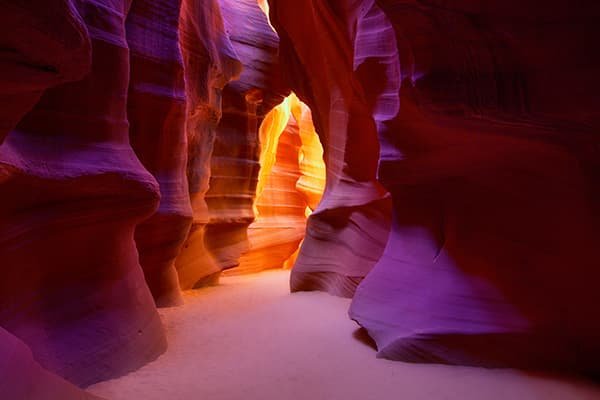
Nestled within the rugged terrain of the American Southwest lies a geological marvel that captivates visitors with its otherworldly beauty and mystical allure – Antelope Canyon. Carved over millennia by the forces of wind and water, this slot canyon showcases nature’s artistic prowess in mesmerizing swirls of sandstone, shafts of light, and vibrant hues that dance across its walls. In this article, we embark on a virtual journey to explore the wonders of Antelope Canyon, uncovering its rich history, iconic features, and the unforgettable experiences that make it a must-visit destination for adventurers, photographers, and nature enthusiasts alike.
1. Geological Formation
Antelope Canyon is a slot canyon located on Navajo land near Page, Arizona, and is divided into two sections: Upper Antelope Canyon (Tse bighánílíní, “the place where water runs through rocks”) and Lower Antelope Canyon (Hasdestwazi, “spiral rock arches”). Both sections were formed over thousands of years by flash floods that carved narrow passageways through the soft sandstone, resulting in the distinctive sculpted walls, smooth curves, and twisting corridors that define the canyon’s unique beauty.
2. Play of Light and Shadow
One of the most enchanting aspects of Antelope Canyon is the interplay of light and shadow that transforms its sandstone walls into a canvas of ever-changing patterns and textures. During certain times of the day, shafts of sunlight filter down through the narrow openings in the canyon’s ceiling, casting ethereal beams of light that illuminate the swirling layers of rock with a warm, golden glow. The effect is nothing short of magical, as the canyon walls seem to come alive with color and movement, creating a visual spectacle that mesmerizes visitors and photographers alike.
3. Photography Paradise
For photographers, Antelope Canyon is a dream come true, offering endless opportunities to capture stunning images of nature’s handiwork. The unique combination of narrow passageways, sculpted sandstone, and shafts of light creates a photographer’s paradise, where every angle reveals a new perspective and every moment yields a breathtaking composition. Whether you’re a professional photographer armed with a DSLR camera or a casual visitor with a smartphone, you’ll find no shortage of iconic shots to capture and memories to cherish for a lifetime.
4. Guided Tours
Exploring Antelope Canyon is an experience best enjoyed with the guidance of knowledgeable Navajo guides who share their expertise and insights into the canyon’s history, geology, and cultural significance. Guided tours are available for both Upper and Lower Antelope Canyon, offering visitors the opportunity to learn about the Navajo people who have called this land home for centuries and gain a deeper understanding of the canyon’s spiritual significance. Along the way, guides share stories, legends, and traditional teachings that enrich the visitor experience and foster a greater appreciation for the natural beauty of Antelope Canyon.
5. Slot Canyon Adventures
Venturing into Antelope Canyon is an adventure unlike any other, as visitors navigate narrow passageways, scramble over rocky terrain, and squeeze through tight spaces in pursuit of discovery. While Upper Antelope Canyon is known for its smooth, sandy floors and relatively easy terrain, Lower Antelope Canyon presents a more challenging trek, with steep ladders, uneven surfaces, and narrow corridors that require agility and endurance to traverse. Regardless of which section you explore, each step brings you closer to the heart of this ancient natural wonder, where the secrets of the earth are written in stone and the beauty of the desert unfolds before your eyes.
6. Cultural Heritage
Antelope Canyon holds deep cultural significance for the Navajo people, who consider it a sacred and spiritual place imbued with the energy of the earth and the wisdom of their ancestors. As visitors journey through the canyon, they are invited to reflect on its natural beauty and contemplate the interconnectedness of all living things, honoring the Navajo principle of hózhó – harmony, balance, and beauty. Respect for the land, the water, and the spirits that dwell within is paramount, as visitors are reminded to tread lightly and leave no trace, preserving the sanctity of Antelope Canyon for future generations to enjoy.
7. Conservation and Preservation
As a cherished natural treasure, Antelope Canyon is committed to conservation efforts aimed at preserving its fragile ecosystem and protecting it from the impacts of overtourism and environmental degradation. Measures such as limited access, regulated visitation, and responsible visitor behavior are in place to minimize the impact on the canyon’s delicate sandstone formations and sensitive wildlife habitats. By supporting sustainable tourism practices and respecting the guidelines set forth by the Navajo Nation, visitors can play a role in ensuring that Antelope Canyon remains a pristine and unspoiled sanctuary for generations to come.
Conclusion
Antelope Canyon is more than just a geological wonder – it’s a testament to the power and beauty of the natural world, a sacred sanctuary that invites visitors to connect with the earth and experience the wonder of creation. Whether you’re drawn to its captivating beauty, its spiritual significance, or its rich cultural heritage, Antelope Canyon offers an unforgettable journey into the heart of the American Southwest. So pack your sense of adventure, your camera, and your spirit of reverence, and embark on an exploration of Antelope Canyon that will leave you awe-inspired and forever changed.
